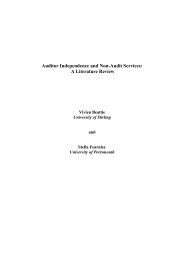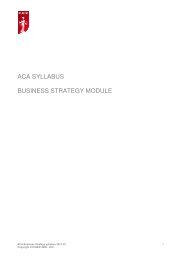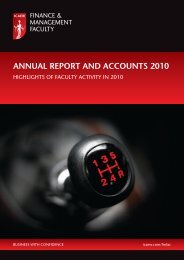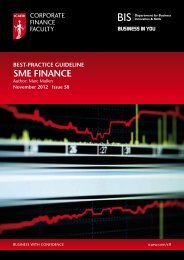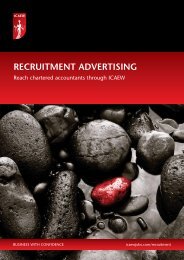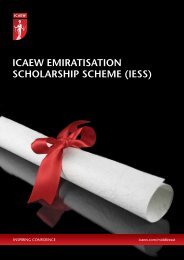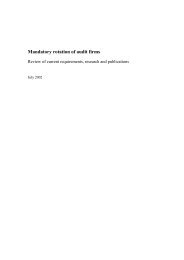Acting in the public interest â a framework for analysis - ICAEW
Acting in the public interest â a framework for analysis - ICAEW
Acting in the public interest â a framework for analysis - ICAEW
- No tags were found...
You also want an ePaper? Increase the reach of your titles
YUMPU automatically turns print PDFs into web optimized ePapers that Google loves.
10. INVITATION TO COMMENT<strong>ICAEW</strong> welcomes comments on <strong>the</strong> <strong>analysis</strong> <strong>in</strong> this report and <strong>the</strong> proposed <strong>framework</strong>.Readers are particularly <strong>in</strong>vited to give <strong>the</strong>ir op<strong>in</strong>ions on <strong>the</strong> assertions noted below, <strong>in</strong>clud<strong>in</strong>gillustrative challenges and examples beyond those which we have noted.Comments on some of <strong>the</strong> assertions are likely to identify areas need<strong>in</strong>g fur<strong>the</strong>r review ofexist<strong>in</strong>g knowledge or fur<strong>the</strong>r research on specific issues. These and comments on o<strong>the</strong>rmatters will be taken <strong>in</strong>to account <strong>in</strong> <strong>the</strong> fur<strong>the</strong>r evolution of this <strong>framework</strong>.1. There is a <strong>public</strong> <strong>in</strong>terest <strong>in</strong> people be<strong>in</strong>g allowed to go about <strong>the</strong>ir bus<strong>in</strong>ess.However, collective <strong>in</strong>dividual actions can result <strong>in</strong> an outcome which is not <strong>for</strong> <strong>the</strong>greater good <strong>in</strong> aggregate, and so <strong>in</strong>terference can sometimes be justified <strong>in</strong> <strong>the</strong><strong>public</strong> <strong>in</strong>terest, even if <strong>the</strong>re is not an overall consensus.2. A detailed general def<strong>in</strong>ition of <strong>the</strong> <strong>public</strong> <strong>in</strong>terest would not be helpful as <strong>in</strong>dividualcircumstances are too variable and detailed def<strong>in</strong>itions would be likely to result <strong>in</strong>un<strong>in</strong>tended consequences.3. ‘The <strong>public</strong> <strong>in</strong>terest’ is often used without a clear understand<strong>in</strong>g of why it is be<strong>in</strong>gused, or sometimes as a smokescreen <strong>for</strong> o<strong>the</strong>r <strong>in</strong>terests.4. We propose a <strong>framework</strong> that identifies a number of key questions to be addressedwhen justify<strong>in</strong>g actions as be<strong>in</strong>g <strong>in</strong> <strong>the</strong> <strong>public</strong> <strong>in</strong>terest. We believe it will assist<strong>in</strong> understand<strong>in</strong>g both by those advocat<strong>in</strong>g a <strong>public</strong> <strong>in</strong>terest measure and thoseassess<strong>in</strong>g it.5. There are a number of threats to a <strong>public</strong> <strong>in</strong>terest decision not actually be<strong>in</strong>g, or seento be, <strong>in</strong> <strong>the</strong> <strong>public</strong> <strong>in</strong>terest. Examples <strong>in</strong>clude past behaviour, self-<strong>in</strong>terest and lobbypressure. We suggest that safeguards should match <strong>the</strong> threat, <strong>for</strong> example act<strong>in</strong>g onfeedback, transparency of process, oversight, and a sense check on understand<strong>in</strong>g.6. We dist<strong>in</strong>guish between matters which are <strong>in</strong> <strong>the</strong> <strong>public</strong> <strong>in</strong>terest and matters <strong>in</strong> which<strong>the</strong> <strong>public</strong> is <strong>in</strong>terested, argu<strong>in</strong>g that <strong>the</strong> latter does not determ<strong>in</strong>e <strong>the</strong> <strong>for</strong>mer.7. Consideration of <strong>the</strong> <strong>public</strong> <strong>in</strong>terest must mean be<strong>in</strong>g open to tak<strong>in</strong>g <strong>in</strong>to account<strong>the</strong> <strong>in</strong>terests of <strong>the</strong> global <strong>public</strong>. However, as a practical matter, not everyone willactually be affected by <strong>the</strong> matter at hand. The relevant <strong>public</strong> will be all those whowill be affected, or who have a legitimate remit to speak <strong>for</strong> those who are.8. There can be constra<strong>in</strong>ts to <strong>the</strong> <strong>public</strong>’s wants through, <strong>for</strong> example, self-<strong>in</strong>terest,mis<strong>in</strong><strong>for</strong>mation, and externalities. In addition, <strong>the</strong>re may be overrid<strong>in</strong>g values, though<strong>the</strong>se should be transparent.9. In pr<strong>in</strong>ciple even small scale matters can be considered to be <strong>in</strong> <strong>the</strong> <strong>public</strong> <strong>in</strong>terest,although <strong>in</strong> practice o<strong>the</strong>r decision-mak<strong>in</strong>g objectives might be more suitable.10. A number of ways to deal with aggregation problems and conflicts are proposed.Many of <strong>the</strong>se are variations or add-ons to utility <strong>the</strong>ory and <strong>the</strong>y <strong>in</strong>clude, <strong>for</strong>example: weight<strong>in</strong>g and rat<strong>in</strong>g; game <strong>the</strong>ory; offsett<strong>in</strong>g payments; Pareto optima;w<strong>in</strong>-w<strong>in</strong> solutions; and impact <strong>analysis</strong>, <strong>in</strong>clud<strong>in</strong>g cont<strong>in</strong>gent valuation.11. We note a number of potential approaches to implementation, summarised as ‘carrot,stick and sermon’. We suggest that <strong>the</strong> appropriate approach depends on; <strong>the</strong> likelyreaction by those affected, which is itself <strong>in</strong>fluenced by factors such as reputationof <strong>the</strong> proposer and closeness of <strong>the</strong> required behaviour to what self-<strong>in</strong>terest woulddictate; <strong>the</strong> nature of <strong>the</strong> en<strong>for</strong>c<strong>in</strong>g structure; and acceptability of alternativebehaviour.68Invitation to comment



